Lunch with... James Weaver & Andy Wallace
Both had F1 ambitions before finding a firmer footing in sports cars, where they collected many an endurance success – along with a rich fund of anecdotes.

James Mitchell
Being a racing driver is, essentially, a selfish activity. Notwithstanding all that Jacky Ickx had to say on these pages last month, and however much the man in the cockpit may acknowledge his debt to his team and even to his team-mate, he is quite understandably out for himself.
That, at least, is how it usually is in single-seaters, all the way up to Formula 1. In long-distance sports car racing, however, things are different. The very nature of the task in hand, grinding through long hours with a car that may be far past its best, sharing your seat and your chances with a co-driver – or in the longer races these days, two or even three co-drivers – means you really have to work together.
James Weaver and Andy Wallace have been friends, and rivals, in sports car racing since the 1980s. They have been team-mates too, sharing cars on many occasions. From the start their careers followed parallel paths: scrimping and saving to get into racing, cutting their teeth in the rough and tumble of Formula Ford, entertaining early F1 ambitions before the inevitable hurdles of budget and opportunity beat them back. Then they discovered sports car racing, which over three decades has given them both a reasonable living and a lot of success.
Both are modest about their achievements. Rather than reeling off a roll-call of their successes, they prefer to recount incidents from a rich fund of tales of the life and times of the journeyman racing driver. But those achievements are considerable. Andy won Le Mans at his first attempt, and has done the race 20 times since, earning three podiums and four class wins. He has won the Daytona 24 Hours three times, and the Sebring 12 Hours twice. Teams that have come after his services include Bentley, Jaguar, Toyota, Audi UK, Cadillac, Harrods McLaren and Panoz. As for James, a trawl of his results over the past 30 years shows he has been on the podium over 200 times, with 100 wins, 69 poles, 76 fastest laps and 41 lap records. His titles include Global GT Champion, Can-Am Champion and Grand-Am Champion.
Andy, now 50, still accepts any decent drive he’s offered. James, six years older, hung up his helmet in 2006. But they remain good mates, and need no persuading to converge for lunch at a Cotswolds pub within easy reach of both, the Swan in the Gloucestershire village of Southrop.
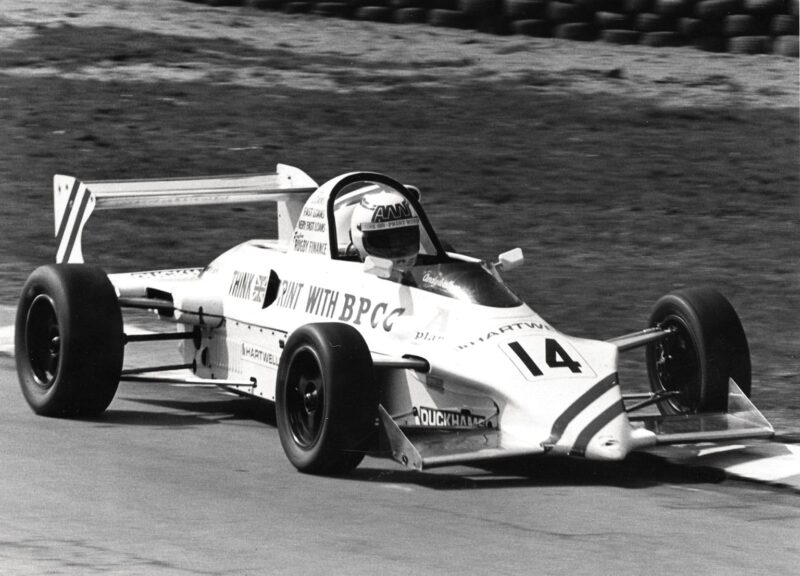
FF2000 in 1984 was a precursor for British F3 for Wallace
Motorsport Images
For both it was tough getting into racing at all, requiring single-minded patience and determination. James was not a success at school: “I couldn’t even rise to the dizzy heights of being rubbish. All I wanted to be was a film star, an engine driver or a racing driver. A look in the mirror told me my chances of being a film star were slim, and steam trains had gone out of fashion, so I defaulted to racing driver. My father, who was a heart surgeon, was horrified – even though he’d helped out on Sid Watkins’ team at the British Grand Prix.”
Having failed his A-levels, James was sent to a crammer in London: but the only course he was interested in was one at the Jim Russell racing school. “I had no money and needed to earn some. So I’d arrive at the crammer each morning, say hello to the tutors, then jump on the tube and go to work all day at Foyle’s Bookshop. I’d go back to the crammer in time to say goodnight to the tutors, and go home. After five months my father realised what was happening and that was the end of the crammer. I’d only saved up enough to do half a Jim Russell course, and the very idea of a car was totally out of reach. But Hawke was one of the top Formula Ford chassis at the time, so I went to their place in Hertfordshire to take a look. It was run by David Lazenby, who’d been Jim Clark’s mechanic at Lotus. I poked my nose into this tiny upstairs workshop and asked for a job. No jobs. So I said, ‘Well, the floor needs sweeping, can I do that?’ I worked all week just keeping the place clean, and at the end of the week I said, ‘See you Monday.’ Dave said, ‘What? Are you coming back?’ ‘Yes’, I said. So he said, ‘OK, I’ll pay you 20p an hour.’ Doesn’t sound much today, but it meant a lot to me: I was getting near to racing cars.
“Dave was the most wonderful person, generous spirited, and one of the old school. He could build a car in a week by himself, pull the tubes out of the rack, stick the chassis together, running gear, bodywork, paint, the lot. His work rate was phenomenal. Yet he found time to teach me everything: how to braze, how to use a capstan lathe. I loved being a mechanic, even though I wasn’t very good at it.”
This didn’t go down well with James’ family, who pushed him into an apprenticeship at Hawker Siddeley as something that might provide better prospects than 20p an hour at Hawke. “I stuck that for about a week, and then I went back to Dave. He said I could start getting bits together to build myself a car. Whenever a customer brought in a wreck to be repaired I’d pile all the redundant remains in a corner to use later. Eventually I found a rusty old Supervee chassis, chopped the engine bay off, whacked a Formula Ford back end on it, hung on some bits from the pile, and I had a racing car – three years after I’d started sweeping the floor.”
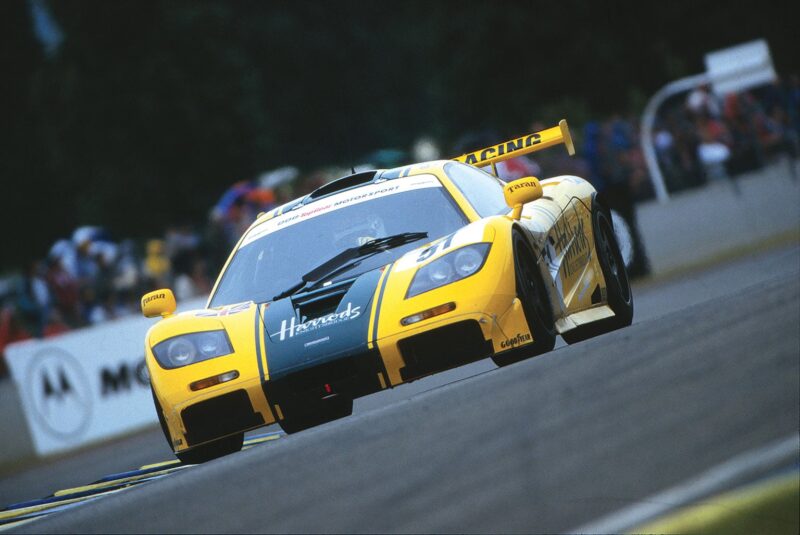
In 1995 Harrods-backed McLaren GTR he shared with Derek and Justin Bell. they finished third
Motorsport Images
As for Andy, he was a race fan from an early age. He lived 30 miles from Silverstone, and from the age of 12 he cycled to watch every meeting he could. “I’d set off at 6am, often in pouring rain, with my cheese and pickle sandwich on the carrier, watch from every corner, drink it all in, cycle home, usually still raining, get back in the dark. All the time I was saying, ‘This is what I want to do’. For my 15th birthday my parents gave me a trial lesson at the Silverstone Jim Russell school – half a day round the cones on the Hangar Straight. I was even smaller then, and they had to fill up the cockpit with cushions so I could see out. That made me determined to do the whole course, which cost £500. So I got myself a job after school, £2 a night washing dishes in the kitchens of one of the Oxford colleges. As soon as I’d saved up enough I’d go back to Silverstone for another lesson. It took me over two years to finish the course.
“Now I needed a car. I saw an ad for a 1973 Hawke for sale in Scotland for £1450. I tried to get a loan, but banks don’t lend teenagers money to buy second-hand racing cars. Then I had a brilliant idea. I went to the nearest used car lot, bought a car for £1800 on hire purchase, sold it to somebody the same afternoon at a £200 loss, and now I had £1600. They won’t allow you to do that these days. I persuaded the Scotsman to come down the M6 as far as the Sandbach Services, bought an old trailer off Jonathan Palmer for £50 and hitched it up to my father’s Austin Maxi. At the service area the Scotsman pulled this Hawke DL11 out of his converted bus and said, ‘Take it for a run.’ I roared around the car park, and then he took me into the bus for a cup of tea and we did the deal. He obviously realised I was on a shoestring, because after I’d handed over the money he gave me back a £20 note and said, ‘Buy yourself some breakfast and a tank of fuel to get home.’ A Scotsman, too: I must have looked desperate.
“I took it home, took it all to bits and spread it all over my parents’ lawn to learn how it worked. Then I put it back together, and took it to Silverstone for a test. I knew what a good FF lap time was, and soon I was getting pretty near it. I’m thinking, at this rate I could be on pole for my first race. Then somebody spun at Woodcote, right in front of me. I clipped his right front wheel and it launched me. I did three barrel-rolls, landed upside down and skated along on the roll bar, coming to rest precisely where pole position was painted on the road.
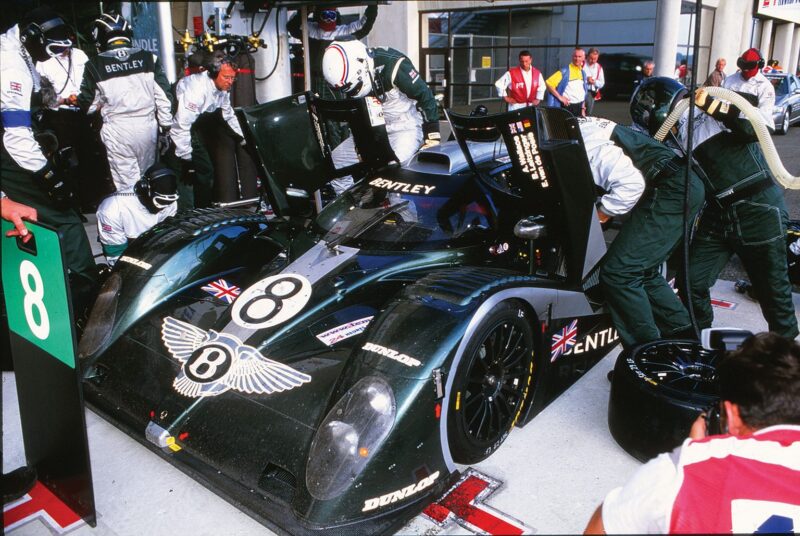
Wallace/Leitzinger/Van de Poele Bentley lost out only to the top three Audis at Le Mans in 2002
Motorsport Images
“My dad said, ‘Right, you can forget this silly idea of being a racing driver. Put the bits in a box, sell it, and get yourself a proper job.’ I signed on as an apprentice fitter with British Gas, but that was only to pay to repair the Hawke. British Gas didn’t last long because I was always taking days off to go testing, so I went to work for the Jim Russell school, first as a mechanic and eventually, would you believe, as an instructor. Meanwhile I’m doing the Star of Tomorrow championship. Race one, fighting for the lead, spin off, work back to third by the finish. Race two, last lap, I try to go from third to first and straight into a concrete wall. That was £500 worth of damage. My dad said to his boss at work, ‘If my son paints his racing car in your company colours, will you give him £500?’ He did, we got the car mended again, I won six out of 12 rounds, and I won the Star of Tomorrow.”
James’ early FF days were just as frantic. “In those days, whenever there was an accident I couldn’t wait to join in. It was a sort of magnetic force, sucking me in. One weekend I was running a borrowed Van Diemen at Snetterton on the Sunday, and then at Thruxton on the Bank Holiday Monday. One of the works Van Diemens had crashed at Snet, and [Van Diemen boss] Ralph Firman said it had a really good engine, so why didn’t I take it out of the wreck and put it in my car. By the time I left the Snetterton paddock for Hampshire it was 1am. Drove cross-country to Thruxton, kipped for an hour or two in my tow-car, then failed scrutineering because of a gearbox leak. Fixed that, had a nice nap before the race, and by the time I got to the grid I was feeling quite frisky.
“Come the race I’m whistling through the flat-out bit around the back, right on the tail of Mike Thackwell, when he spins. I’d read that when somebody spins in front of you, the clever thing to do is aim for the tyre smoke, because by the time you get there he’ll have moved. But Mike cleverly caught the spin and flicked it back the other way. The other schoolboy error I made was I never thought of adjusting my speed, I just kept my foot in. When I hit him my car took off and came down on its nose, and that chopped it up pretty well. I bent my legs a bit, so fellow FF racer Jonathan Palmer, who was studying to be a doctor, gave me a lift home. I was lying groaning in the back of his old XJ6 tow-car, which he always drove at dangerous speed despite the trailer. He diverted via his flat in Blackheath to get me some hideous painkillers, I think they were horse tranquillisers, and said, ‘Have a handful of these and shut up.’”
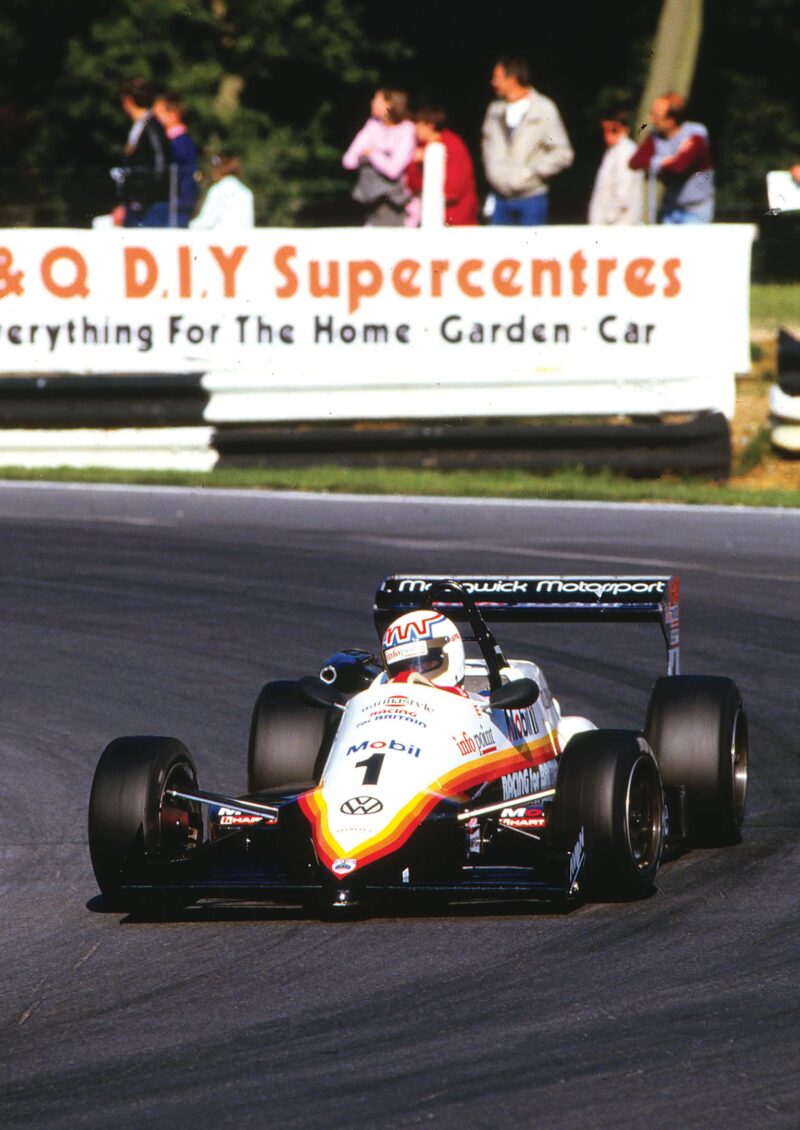
British F3 Championship win with Madgwick Motorsport in 1986 led to Benetton F1 test
Motorsport Images
For both Andy and James the next goal had to be Formula 3, although James spent 1980 in Sports 2000, finishing championship runner-up. “A chap called Joe Chamberlain approached Tiga wanting to back a young driver, and Howden Ganley very decently recommended me. We had enough money to do half an F3 season in 1981. Then for ’82 I got in with Eddie Jordan. Tommy Byrne was meant to drive Eddie’s car, but they fell out, so he gave the drive to me. We only did four rounds of the European F3 Championship, and I won three and was second in the other. The plan was to have a proper season with Eddie in ’83. The contract was drawn up, and I’d got Yokohama to put in £15,000. Then Byrne came up with some money. EJ switched back to Tommy, told Yokohama I was driving for somebody else, and kept their money too. So 1983 was a washout for me.”
Andy, after a spell in FF2000, had a superb first F3 season in 1985 with Reynard and Swallow Racing, finishing second in the British championship. In ’86, his Reynard now run by Madgwick Motorsport, he won eight rounds, finished second twice, tied up the F3 title and won both heats of the prestigious Macau Grand Prix. “On the back of that I got my first ride in an F1 car. Benetton tested a raft of drivers at Donington at the end of ’86, from Giovanna Amati to Otto Rensing. I was second-fastest to Emanuele Pirro, who had a lot more experience and had been doing well in F3000. Eventually he replaced Johnny Herbert at Benetton. Early in 1987 I had a call from Roger Silman at TWR, offering me a Jaguar ride for Le Mans. I said, ‘Thanks but no thanks, I’m going to do F1.’ How stupid was that? I did the rounds of the F1 teams, and Arrows and Tyrrell both offered me a drive – if I brought £600,000. As if. I was the first winner of the British F3 Championship for 20 years not to make it to F1.
“So I tried to do F3000, on an F3 budget, with Madgwick Motorsport. The March we started with was the wrong car, but mid-season we borrowed a Lola, and from then on I was qualifying at the front and leading the odd race. In the final in Spain I led for 50 laps, then tripped over a backmarker. So I never won in F3000.”
James didn’t get as far as an F1 test. “I had a good chance in F3000 driving for Ron Tauranac, but I messed up. In ’85 the Lola had a handling problem and nobody wanted to drive it, so they put me in it for a couple of races. Ron said, ‘If you can finish in the top 10 in that thing I’ll give you a ride in a Ralt.’ Well, I scraped home 10th at Zandvoort, so in ’86 Ron put me in the Ralt for Spa and I qualified third. But we had no time to bed in new pads, so I tried to do it on the way to the start. I was sitting there on the grid with smoke pouring out of the calipers. At the first corner I realised I had a serious braking problem, and at the second I just hit the guard rail head-on. Ron gave me another chance at the Bugatti circuit four months later, but we struggled a bit, finished eighth.
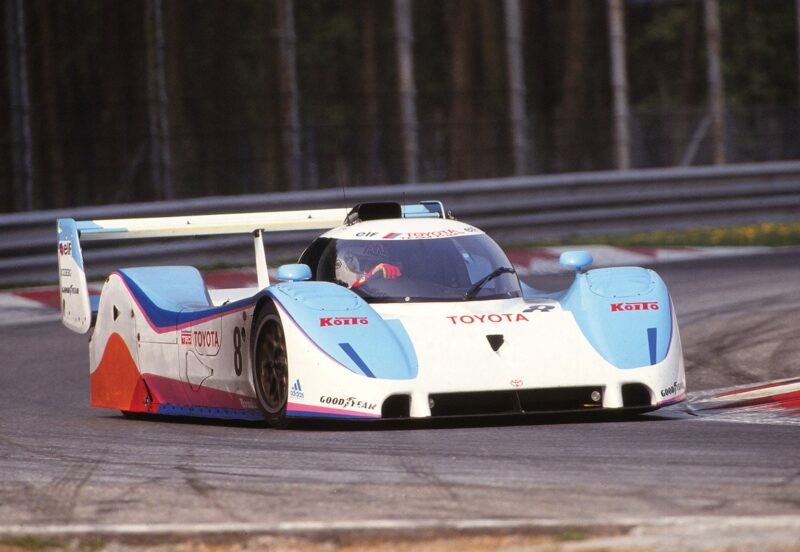
Wallace/Lammers Toyota at Monza in 1992
Motorsport Images
But as for F1 ambitions, what changed everything was that episode with Eddie Jordan. That’s when I decided I wasn’t cut out for all the skulduggery necessary to wangle your way up the single-seater ladder. I loved racing, but I wasn’t interested in conning and conniving to be in F1 to the exclusion of everything else.
“I’d first done Le Mans in 1983 for Mazda, with Steve Soper and Jeff Allam. That little 717C only had 300bhp, but it could do 197mph because it had no downforce. On the Mulsanne it wasn’t stable enough to change lanes. When the big Porsches went past, the slipstream would blow you all over the road. I drove BMW touring cars in ’84, and a Chevron B36 with Eddie Arundell, and we had some success with that. And Tiff Needell and I shared Tetsu Ikuzawa’s Dome in Japan, and we had a lot of fun. Then in ’85 I was working at Reynard, just making the tea really, and Keith Greene rang. He was looking after the Richard Lloyd Porsche 956 which Jonathan Palmer and Jan Lammers were going to drive at Le Mans. But Jan had dropped out for some reason, so Keith said, ‘Come and drive.’ ‘I’m not fit enough,’ I said, ‘ I can’t run 100 yards without getting out of breath.’ A day or so later Keith rang again. ‘You’re going to have to come, there’s nobody else.’
“So I did it, and we finished second, ahead of the Bell/Stuck works Porsche, even after losing three laps in the pits on Saturday night with an electronic problem.” In fact Palmer and Weaver, those old Formula Ford sparring partners, went brilliantly well, holding second behind the winning Joest Porsche for most of the first seven hours; Lloyd only drove one stint in the race. After the delay they were back in second by 8am on Sunday, holding it to the end. “I found the whole thing quite intimidating. What you don’t realise with a big sports car in low-downforce Le Mans trim is how much it wanders around at over 200mph. If you try to fight it you wear yourself out, so you just have to let it have its head. And JP was a bit porkier than me, so I was rattling around in the seat.
“Keith Greene was fantastically good at his job. As an ex-driver, he really understood what a driver needed. In the pitstops – no radios then – he’d orchestrate everything with a gesture or a raised eyebrow, and the mechanics would follow him like musicians follow a conductor. Now it’s just the team manager barking orders at the mechanics over their headsets.”
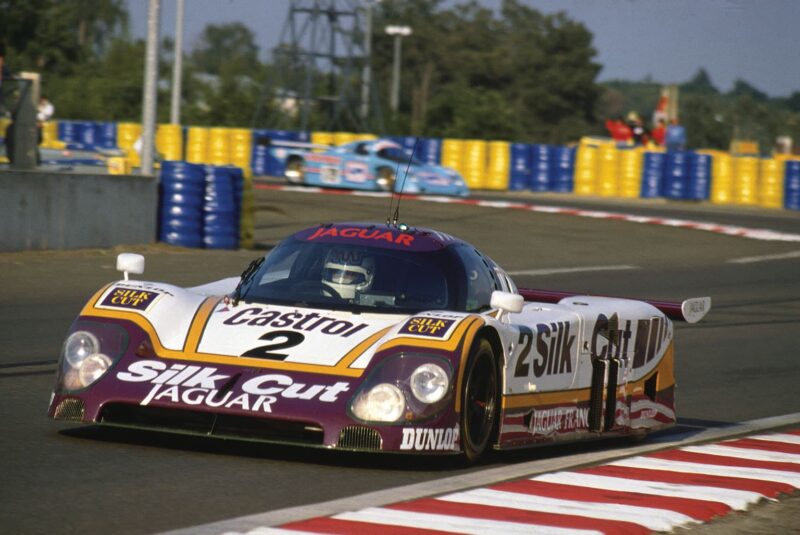
Jan nursed Jaguar XJR-9 home despite a failing gearbox
Motorsport Images
Andy, having kicked himself for turning down the Le Mans offer from TWR in 1987, didn’t need asking twice when Roger Silman called again in ’88. “They set up a test at Paul Ricard, which I knew from driving a 500kgs 180mph F3000 car that stayed glued to the road. Now I was in this great big Jaguar XJR-9, in low-drag Le Mans set-up, and at 205mph it was swerving all over the place, using the whole width of the track. You really had to manhandle it: no power steering then, of course. It was a shock to the system. Tom [Walkinshaw] decided to play me in at Jerez, which I did with John Watson and John Nielsen, we were second there, and then I did Road Atlanta with the IMSA team, co-drove with Davy Jones and finished fourth.

Andy (left) savours victory at Le Mans in 1988 alongside Dumfries, Lammers and Walkinshaw
Motorsport Images
“There was no Le Mans test weekend then, but I studied the gear charts before practice, and I knew 6000rpm was 200mph. On my first lap I ran it up to 6000rpm on the Mulsanne and I said to myself, this is as fast as I want to go. You’re in the grooves worn in the RN138 by heavy trucks, you catch a slower car and need to go around it, you put on a bit of lock but the camber pushes you back, you put on a bit more, the back of the slower car is rushing up to you, you climb up the camber and lurch down the other side, and you almost steer into the opposite barrier. There I am thinking, ‘This is jolly fast, I want my mum’, and another XJR-9 comes past like I’m tied to a post. So the next lap I held the throttle down, my toes curling up in my shoe, got to the kink which everybody said was flat, but I lifted. But on my third lap I managed the kink without lifting, and then it was alright. We were doing 248mph that year.
“Dunlop were very unhappy with the safety margin of the radials, which were only good for 400kph (248.5mph) and we were just about on that, so they insisted we went to cross-plies. Suddenly, even with the same rolling diameter, the gearing was all wrong. That’s because cross-plies grow at maximum speed. So instead of gearing for 248 we geared for 230, and that, with the tyre growth, got us back to 248. But it felt like at least 300. You tell yourself, if a tyre goes bang now I’ll hit the barriers so hard I won’t know anything about it. In fact that’s what happened to Win Percy’s XJR-8 the year before. The Jaguars had tyre heat sensors with four red lights on the dash, one for each tyre, so if a tyre got hot – like with a slow puncture – the appropriate light would glow. Win had a slow puncture, but it had been raining and the sensor lenses were dirty, so they didn’t pick it up. At 235mph the tyre exploded, took out a lot of the bodywork, he went upside down and wore away his helmet going down the road. But he was OK.
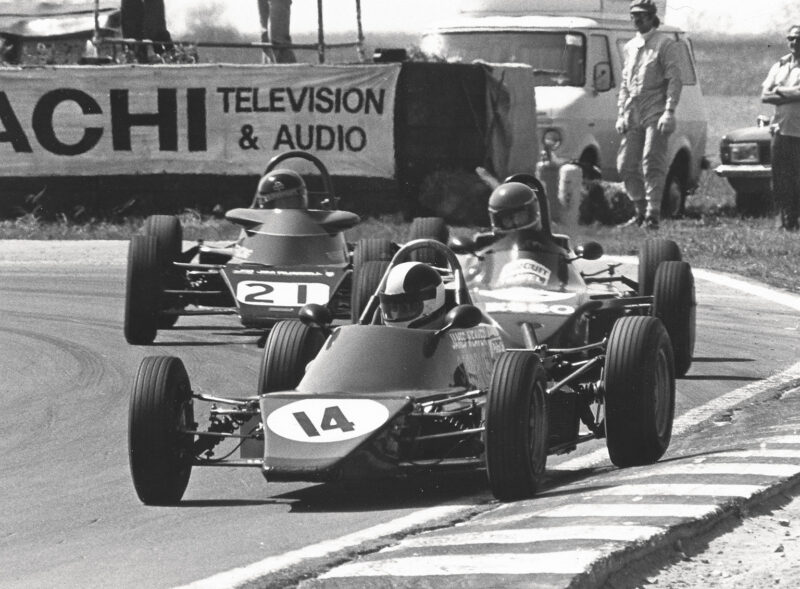
Weaver started his racing career aboard a FFord Hawke. This is from Snetterton
Motorsport Images
“In ’88 Mercedes had a Michelin radial blow in qualifying, just after the kink, and they pulled out. So it was us versus Porsche. I was teamed with Lammers and Johnny Dumfries, and before the race Jan said, ‘Look, our gearbox is going to break. So if we drive like we know it’s going to break, maybe we’ll get through. We have to trust each other to drive calm.’” Even so, their number two XJR-9 was the lead Jaguar from the start, and ran at the front for most of the distance. The Boesel/Pescarolo/Watson XJR-9 went out during the night with, yes, a broken gearbox. The number one Brundle/Nielsen Jaguar blew its engine. But number two was still leading from the Bell/Stuck/Ludwig Porsche as the clock moved towards 4pm on Sunday.
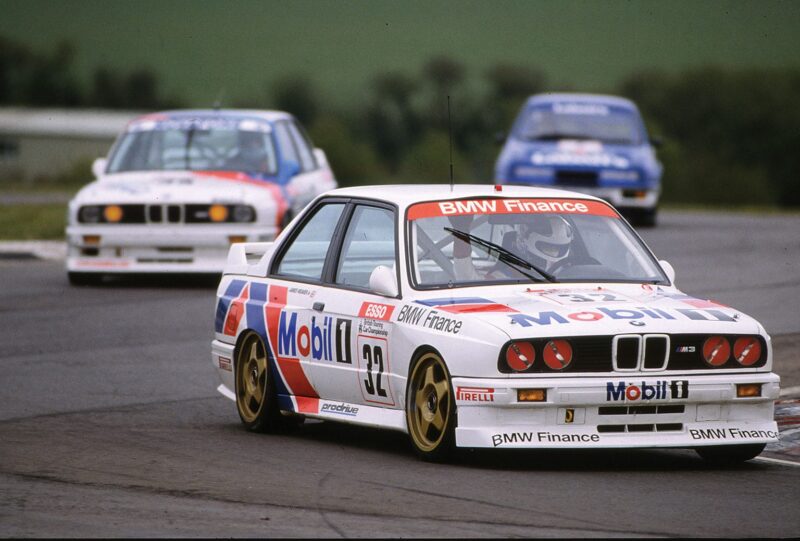
James almost won BTCC title aboard Prodrive BMW in 1989, losing out by one point
Motorsport Images
“Then, 25 minutes before the end, with Jan in the car and the Porsche on the same lap, the gearbox mainshaft snapped. It was being held together by third gear. Jan is very good mechanically so he nursed the car on. He knew Porsche were listening to our radio, so he didn’t talk about it. As the other two surviving Jaguars, lying fourth and 16th, lined up for a formation finish, the plan was that if Jan lost all forward motion they would push him around the last lap if necessary to keep him going to the flag. I’m not sure what the officials would have said about that. Anyway, Jan got it home, and Jaguar won Le Mans for the first time for 31 years. Back at TWR, when they opened up the gearbox, all the bits just fell out.
Tom was a big, loud, scary guy, and I was petrified of him. When you sat in his office and he talked to you – “Now, laddie…” – you felt like a mouse. He paid you to do a job – my fee for Le Mans was £5000 – and he expected you to do as you were told. If you said the car was understeering, he’d let you make one change. Then, if you were still complaining of understeer, he’d get on the radio and say, ‘Laddie, either shit or get off the pot.’ After Le Mans he offered me the Brands Hatch 1000, which I won with Martin Brundle and John Nielsen, and after that he offered me a proper contract for 1989.”
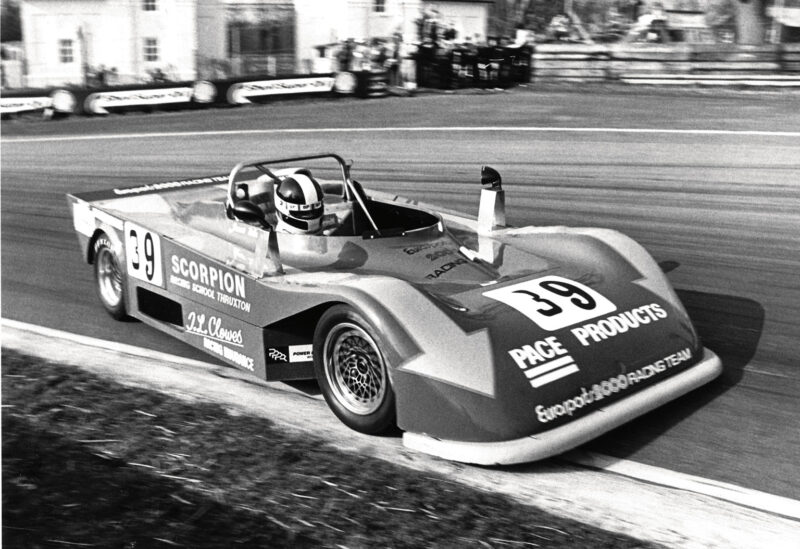
Sports 2000 in 1980, when he was runner-up
Motorsport Images
James, after his Le Mans second place in 1985, was offered a Nissan drive for ’86. “It was a nightmare. Gordon Coppuck had designed a good chassis, and the 3-litre V6 twin-turbo had about 1000 horsepower if you cranked it up. They also had an earlier ’85 version which wasn’t as quick. So the Japanese stars, led by Aguri Suzuki, were put in the new car, and I drove the old one with Masahiro Hasemi and Takao Wada. Keith Greene was the team manager, constantly at odds with the Nissan people who wanted to do things their way, and after endless dramas in practice Anglo-Japanese relations deteriorated rapidly. Come the race, when the ’86 car expired after four hours, they decided to switch Suzuki into our car to give it an all-Japanese line-up, so I was stood down. I was pretty cheesed off with the whole thing by now, so I didn’t terribly mind, and retired to the motorhome for some liquid refreshment. A few hours later the Japanese realised that the Le Mans rules then only permitted three drivers, and they hauled Suzuki out. I’d had several glasses of wine by now, so Keith told me to run twice round the motorhome, and if I could manage that without falling over I was to get back in the car. I did a couple of night stints and was just getting something to eat when the Japanese knocked on the motorhome again: it had emerged that Takao Wada couldn’t see at night, so they wanted me back in the car. Keith employed his best Anglo-Saxon on the wisdom of employing a driver at Le Mans with night blindness, and I clambered aboard again.
“Now the car wouldn’t start because the battery was flat. Jump starts weren’t permitted at Le Mans, but the Japanese had a fiendish plan to jump it without being seen. At the back of the pit a slave battery was hastily taped to a mechanic’s chest, with the leads coming down his sleeves. He then knelt down behind the car and, holding the crocodile clips in his hands, put them on the terminals – and at once, with a strangled cry, fell twitching to the ground, smoke wisping out of his sleeves, having shorted himself. While the outraged French officials were waving their arms and the Japanese were bowing obsequiously, Keith quietly got one of the English mechanics to fit another battery, and told me that if I drove off in the evidence, all would be forgotten by the next pitstop. He was right. We eventually finished 16th, 700 miles behind the winners.”
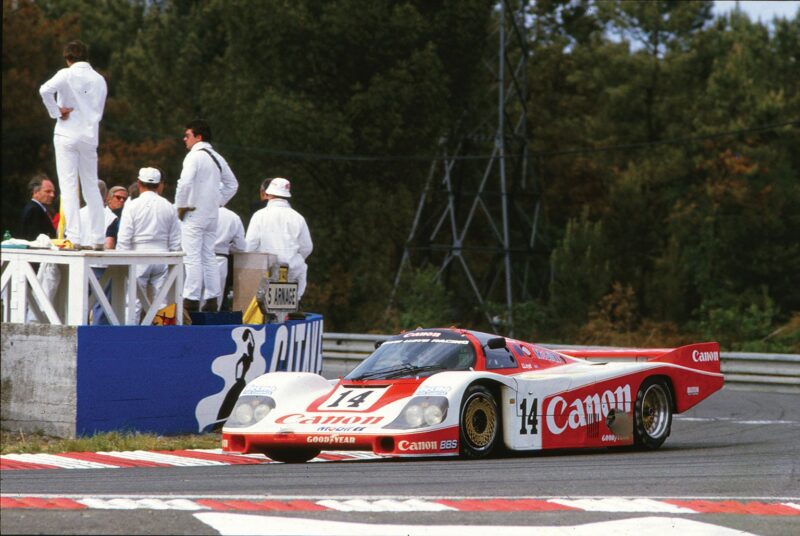
Weaver almost turned down Porsche 956 ride with Richard Lloyd and Jonathan Palmer at Le Mans in 1985. They finished second
Motorsport Images
In 1987 James started driving for Rob Dyson’s highly professional American sports car team, based in Poughkeepsie, New York. It was the start of a remarkable relationship that lasted for 20 successful seasons, up to James’ retirement. He still does a lot of advisory work for Dyson and attends many of its races. He won the USRRC Can-Am series in 1998, and was Grand-Am champion in 2000 and ’01. “It was my job to set up the cars, and everything was put at my disposal. Nowadays there are computers to tell drivers what they think they want to know, and they don’t know how much they don’t know. Rob is a big enthusiast, and he gets a massive buzz out of the art of the thing, if you like. He doesn’t care what the computer says. If you think different front springs will make the car drive better, he’ll say, ‘Fine, just do it.’”
James still found time to race in the UK and Europe – his Prodrive BMW came within a point of winning the 1989 British Touring Car Championship – and in ’96 he and Ray Bellm won what was then the Global GT Championship, in Bellm’s McLaren GTR. “Ray was brilliant with me, very professional. He had a chip on his shoulder about being perceived as a rich patron rather than a serious racer, but in fact he drove extremely well.”
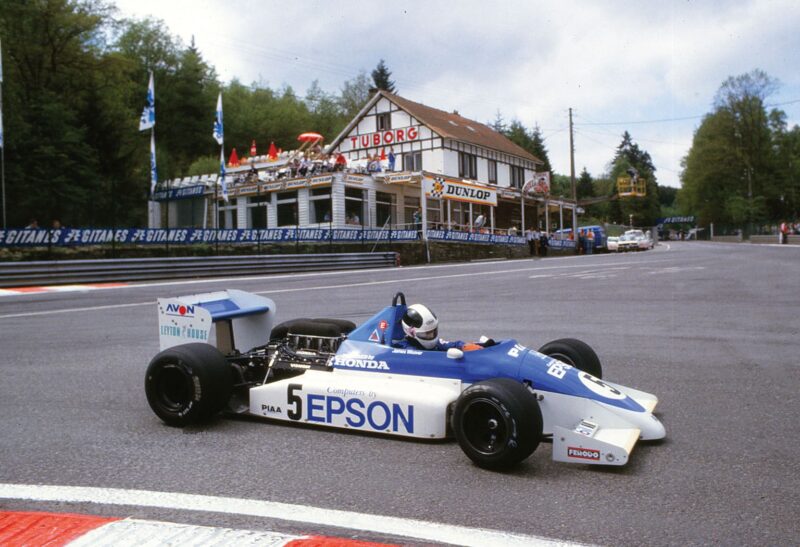
Ralt F3000 drive at Spa 1986 didn’t live up to promise. James qualified third but crashed out
Motorsport Images
Andy’s reputation burgeoned in North America, with his Jaguar XJR victory in the 1990 Daytona 24 Hours and two back-to-back wins in the Sebring 12 Hours with Dan Gurney’s Eagle-Toyotas in 1992/3. It was only a matter of time before James suggested to Rob Dyson that Andy would make a good team member when available. At Daytona in ’97 the Weaver/Wallace Riley & Scott blew its engine, so they took over the sister car and won with that.
Andy also drove in Group C for Toyota. “I joined them in 1991 when the cars were being built, and raced them in ’92/93: 750kg cars with full ground effect, and 3.5-litre V10s like F1 cars. Toyota did everything right, but Peugeot did it all a bit better, and kept beating us. I had to do a lot of work on my neck for that car. In a 200mph corner like Signes at Paul Ricard you’d be pulling 4.7g laterally. You’d fight to keep your head up, but by the time you got to the apex you’d be trying to control the car with your head resting on your shoulder. If it had jumped sideways you’d have lost it.
“The heat was a killer in that car. Our trainer had us riding exercise bikes in a sauna to get us to adapt. We wore a cool suit, plus a system with a metal strip running across your skull inside your helmet which delivered a burst of cooling gas out of a canister when you pushed a button. That got banned because the authorities weren’t sure the gas was harmless. Also, the Elf qualifying fuel was so potent that in a closed car the fumes would make the driver throw up, so you couldn’t spend more than a lap or two in the car – until they put in a perfumed additive which solved it.”
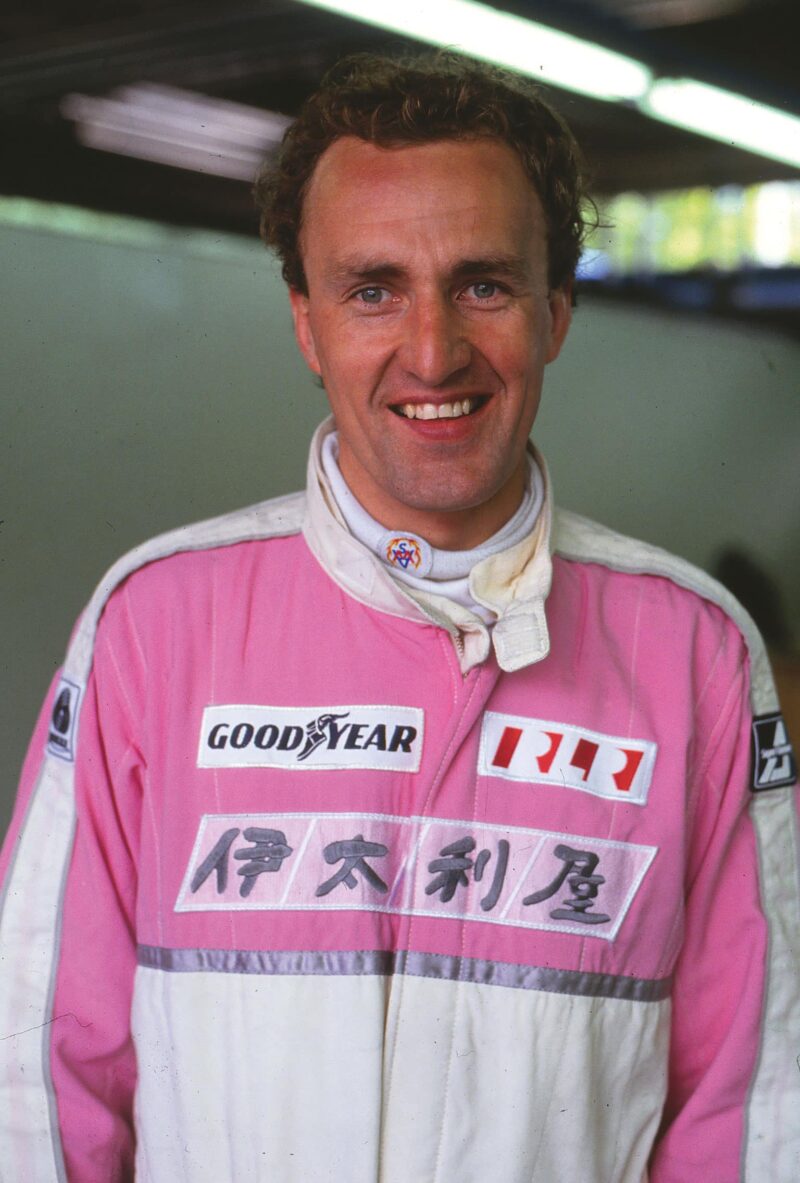
Pretty in pink for 1990 Le Mans with fiery Porsche 962
Motorsport Images
James: “I struggled with fitness until I met Tom Ryan, who’d been the Jaguar physio. He had an excellent programme using light weights and lots of stretches, and I never had a problem again. Daytona is physically demanding, because on the banking the side loading is always on you, and if you release your grip on the steering the car wants to go into the wall. Before power steering, it was physical effort all the time. Le Mans is more mentally demanding because you’re flat out for so long, and you have to make so many judgement calls among the slower cars.
“I had a propensity for catching fire at Le Mans. In ’87, ’89 and ’90 in Richard Lloyd’s Porsche 962s we caught fire every time. In ’87 I was coming out of Mulsanne Corner in heavy rain at about midnight when I realised we were alight. By the time I stopped the windscreen had melted and my shoes were on fire. In ’89 with three hours left, Tiff at the wheel, the car came past the pits ablaze. In ’90 a left rear tyre popped going into Indianapolis at 3am, tore out the brake lines and the turbo oil feed. By the time I got back to the pits the car was burning merrily.”
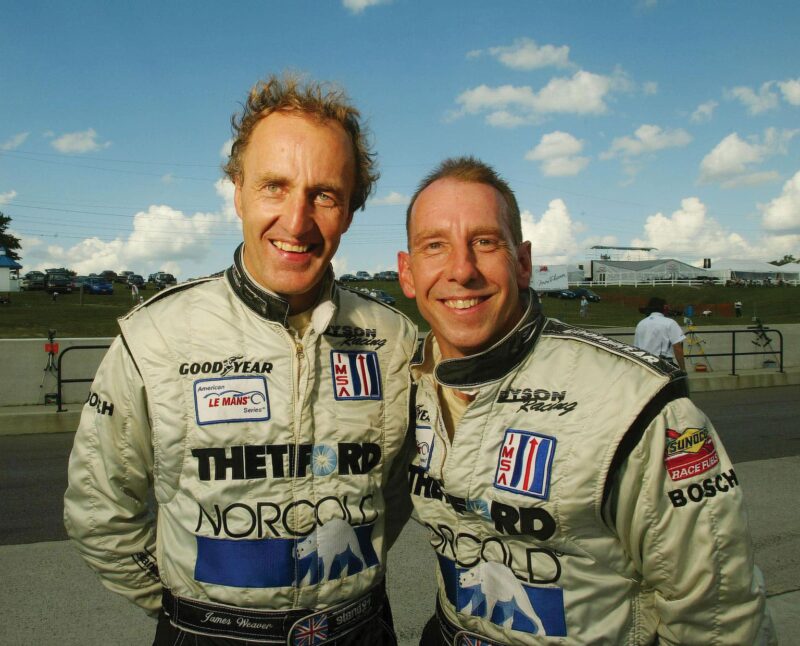
James and Andy qualified first and second for Dyson’s ALMS team at Mosport in 2003
Motorsport Images
The nearest Andy came to repeating his 1988 Le Mans win was with the Harrods-sponsored, Dave Price-run McLaren GTR in ’95, shared with Derek and Justin Bell. “It rained for most of the race. There was a river running across the track as you got into sixth at the start of Mulsanne. Derek was wonderful. Not a man to set up a car: he just drove what he was given, with immense talent. We were leading from 3am almost to the end. Then the clutch master cylinder failed. The McLaren had synchro: if it had been a dog ’box we could have coped. We had to leave it in sixth for the final hour, and dropped to third.”
At Le Mans in 1999 Andy and James shared an Audi UK R8C, but retired with transmission woes. Andy was on the Bentley strength in 2001, finishing third, and in ’02, finishing fourth. They also both drove the thunderous front-engined Panoz. Andy recalls: “The noise inside the car sapped your will to live, like driving with a dustbin lid on your head and somebody beating a tattoo on it with a baseball bat. Changing drivers once, as I did up the belts it yanked an earplug out, and I had to do a double stint. I think it was Wednesday before the ringing in my head stopped.” James agrees: “It was so hot in there, I once had an earplug float out of my ear because of the sweat. In the end I asked to be released from my contract, because it was destroying my hearing.”
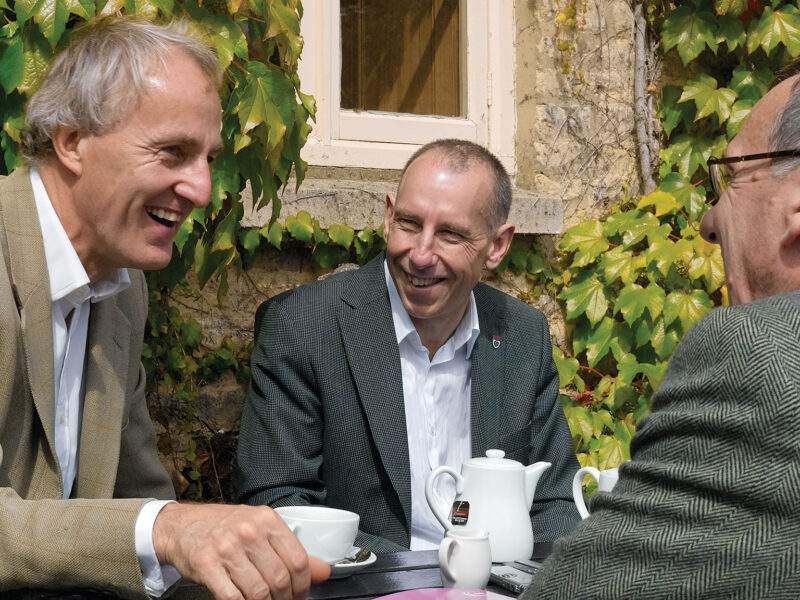
James and Andy were friends and rivals in sports car racing
With few exceptions, endurance racers don’t get particularly rich, or particularly famous. But, if you believe James Weaver and Andy Wallace, they have a lot more fun. “The enjoyment you get out of being part of a team effort in sports car racing,” says James, “is far greater than faffing about in a single-seater trying to look after your own best interests.” Andy concurs: “That’s the essence of it. When you’re in single-seaters everybody’s out to get you. In sports car racing, if you want to get anywhere you have to work with your team-mates, and trust each other.”
As ever James, in his self-deprecating way, has the last word. “In life people give up too easily. To succeed you don’t have to be that good – in my case, anyway. You just mustn’t give up. When I moved into sports cars, and found it was full of camaraderie and fun, I realised I wasn’t the sort of chap to sun myself on a big yacht in Monte Carlo as an F1 millionaire. I’d rather be in a rowing boat, laughing with all my mates.”

